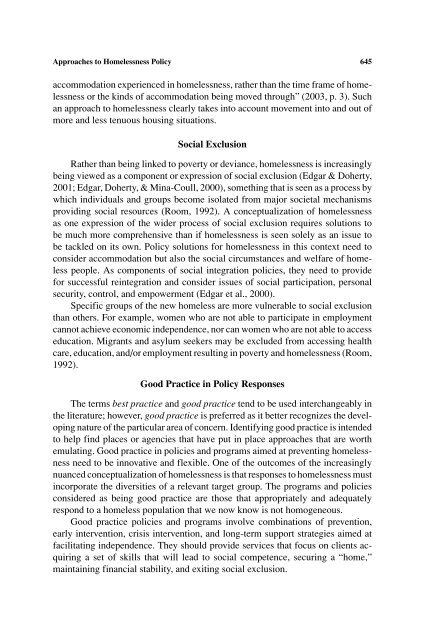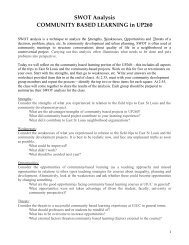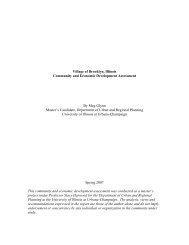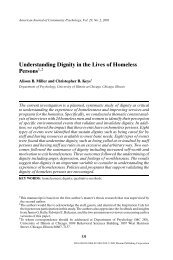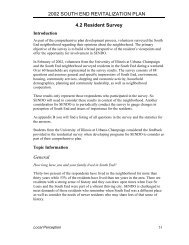Approaches to Homelessness Policy in Europe, the United States ...
Approaches to Homelessness Policy in Europe, the United States ...
Approaches to Homelessness Policy in Europe, the United States ...
Create successful ePaper yourself
Turn your PDF publications into a flip-book with our unique Google optimized e-Paper software.
<strong>Approaches</strong> <strong>to</strong> <strong>Homelessness</strong> <strong>Policy</strong> 645accommodation experienced <strong>in</strong> homelessness, ra<strong>the</strong>r than <strong>the</strong> time frame of homelessnessor <strong>the</strong> k<strong>in</strong>ds of accommodation be<strong>in</strong>g moved through” (2003, p. 3). Suchan approach <strong>to</strong> homelessness clearly takes <strong>in</strong><strong>to</strong> account movement <strong>in</strong><strong>to</strong> and out ofmore and less tenuous hous<strong>in</strong>g situations.Social ExclusionRa<strong>the</strong>r than be<strong>in</strong>g l<strong>in</strong>ked <strong>to</strong> poverty or deviance, homelessness is <strong>in</strong>creas<strong>in</strong>glybe<strong>in</strong>g viewed as a component or expression of social exclusion (Edgar & Doherty,2001; Edgar, Doherty, & M<strong>in</strong>a-Coull, 2000), someth<strong>in</strong>g that is seen as a process bywhich <strong>in</strong>dividuals and groups become isolated from major societal mechanismsprovid<strong>in</strong>g social resources (Room, 1992). A conceptualization of homelessnessas one expression of <strong>the</strong> wider process of social exclusion requires solutions <strong>to</strong>be much more comprehensive than if homelessness is seen solely as an issue <strong>to</strong>be tackled on its own. <strong>Policy</strong> solutions for homelessness <strong>in</strong> this context need <strong>to</strong>consider accommodation but also <strong>the</strong> social circumstances and welfare of homelesspeople. As components of social <strong>in</strong>tegration policies, <strong>the</strong>y need <strong>to</strong> providefor successful re<strong>in</strong>tegration and consider issues of social participation, personalsecurity, control, and empowerment (Edgar et al., 2000).Specific groups of <strong>the</strong> new homeless are more vulnerable <strong>to</strong> social exclusionthan o<strong>the</strong>rs. For example, women who are not able <strong>to</strong> participate <strong>in</strong> employmentcannot achieve economic <strong>in</strong>dependence, nor can women who are not able <strong>to</strong> accesseducation. Migrants and asylum seekers may be excluded from access<strong>in</strong>g healthcare, education, and/or employment result<strong>in</strong>g <strong>in</strong> poverty and homelessness (Room,1992).Good Practice <strong>in</strong> <strong>Policy</strong> ResponsesThe terms best practice and good practice tend <strong>to</strong> be used <strong>in</strong>terchangeably <strong>in</strong><strong>the</strong> literature; however, good practice is preferred as it better recognizes <strong>the</strong> develop<strong>in</strong>gnature of <strong>the</strong> particular area of concern. Identify<strong>in</strong>g good practice is <strong>in</strong>tended<strong>to</strong> help f<strong>in</strong>d places or agencies that have put <strong>in</strong> place approaches that are wor<strong>the</strong>mulat<strong>in</strong>g. Good practice <strong>in</strong> policies and programs aimed at prevent<strong>in</strong>g homelessnessneed <strong>to</strong> be <strong>in</strong>novative and flexible. One of <strong>the</strong> outcomes of <strong>the</strong> <strong>in</strong>creas<strong>in</strong>glynuanced conceptualization of homelessness is that responses <strong>to</strong> homelessness must<strong>in</strong>corporate <strong>the</strong> diversities of a relevant target group. The programs and policiesconsidered as be<strong>in</strong>g good practice are those that appropriately and adequatelyrespond <strong>to</strong> a homeless population that we now know is not homogeneous.Good practice policies and programs <strong>in</strong>volve comb<strong>in</strong>ations of prevention,early <strong>in</strong>tervention, crisis <strong>in</strong>tervention, and long-term support strategies aimed atfacilitat<strong>in</strong>g <strong>in</strong>dependence. They should provide services that focus on clients acquir<strong>in</strong>ga set of skills that will lead <strong>to</strong> social competence, secur<strong>in</strong>g a “home,”ma<strong>in</strong>ta<strong>in</strong><strong>in</strong>g f<strong>in</strong>ancial stability, and exit<strong>in</strong>g social exclusion.


